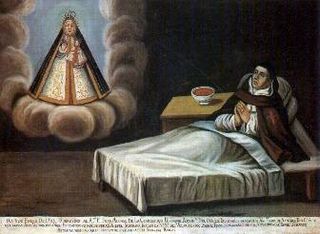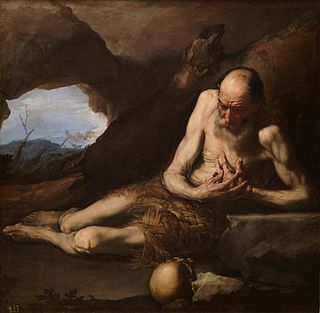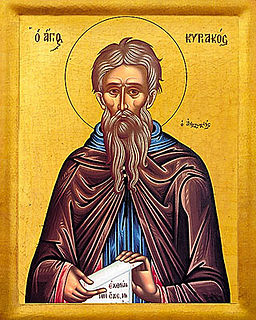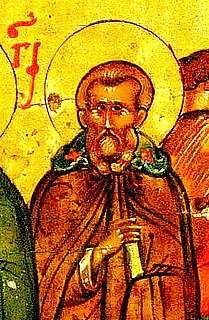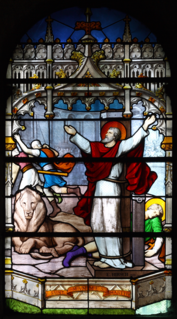Pardus the Hermit | |
|---|---|
| Died | 6th century |
| Venerated in | Eastern Orthodoxy |
| Feast | December 15 |
| Attributes | lion |
Saint Pardus (died 6th century) was a Roman who lived in Palestine. In his youth, he had worked as a camel driver. Once when he traveled to Jericho he witnessed a boy accidentally trampled to death under the legs of his fleet of camels, and from fear of retribution, he fled into hiding and took monastic vows at Mount Arion. [1]
A vow is a promise or oath.
Bearing great feelings of guilt for the death of the boy, Pardus decided to give himself up in an act of extreme penance and offer himself, defenceless, to be eaten by a lion. He entered the den of a lion, but after repeated provocations the lion simply ignored the saint and refused to eat him. With this the monk concluded that God, in his love and grace, had forgiven him of any wrong he may have done. [1]

Penance is repentance of sins as well as an alternate name for the Catholic, Lutheran, Eastern Orthodox, and Oriental Orthodox sacrament of Reconciliation or Confession. It also plays a part in confession among Anglicans and Methodists, in which it is a rite, as well as among other Protestants. The word penance derives from Old French and Latin paenitentia, both of which derive from the same root meaning repentance, the desire to be forgiven. Penance and repentance, similar in their derivation and original sense, have come to symbolize conflicting views of the essence of repentance, arising from the controversy as to the respective merits of "faith" and "good works". Word derivations occur in many languages.
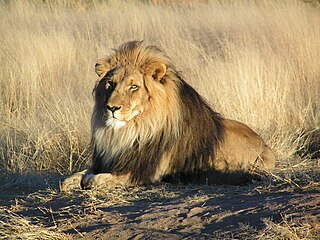
The lion is a species in the family Felidae; it is a muscular, deep-chested cat with a short, rounded head, a reduced neck and round ears, and a hairy tuft at the end of its tail. It is sexually dimorphic; male lions have a prominent mane, which is the most recognisable feature of the species. With a typical head-to-body length of 184–208 cm (72–82 in) they are larger than females at 160–184 cm (63–72 in). It is a social species, forming groups called prides. A lion pride consists of a few adult males, related females and cubs. Groups of female lions usually hunt together, preying mostly on large ungulates. The lion is an apex and keystone predator, although some lions scavenge when opportunities occur, and have been known to hunt humans, although the species typically does not.
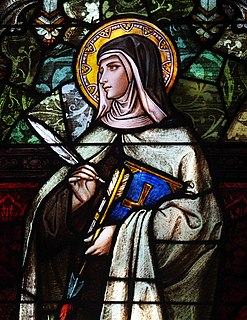
A saint is a person who is recognized as having an exceptional degree of holiness or likeness or closeness to God. However, the use of the term "saint" depends on the context and denomination. In Roman Catholic, Eastern Orthodox, Anglican, Oriental Orthodox, and Lutheran doctrine, all of their faithful deceased in Heaven are considered to be saints, but some are considered worthy of greater honor or emulation; official ecclesiastical recognition, and consequently veneration, is given to some saints through the process of canonization in the Catholic Church or glorification in the Eastern Orthodox Church.
Pardus then returned to his dwelling at Mt. Arion to live out the rest of his life in asceticism and prayer, dying in the 6th century. [1]
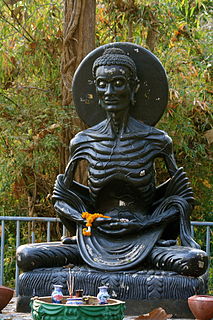
Asceticism is a lifestyle characterized by abstinence from sensual pleasures, often for the purpose of pursuing spiritual goals. Ascetics may withdraw from the world for their practices or continue to be part of their society, but typically adopt a frugal lifestyle, characterised by the renunciation of material possessions and physical pleasures, and time spent fasting while concentrating on the practice of religion or reflection upon spiritual matters.

Prayer is an invocation or act that seeks to activate a rapport with an object of worship through deliberate communication. In the narrow sense, the term refers to an act of supplication or intercession directed towards a deity, or a deified ancestor. More generally, prayer can also have the purpose of thanksgiving or praise, and in comparative religion is closely associated with more abstract forms of meditation and with charms or spells.
Pardus the Hermit is commemorated 15 December in the Eastern Christian Churches. [2] [3]
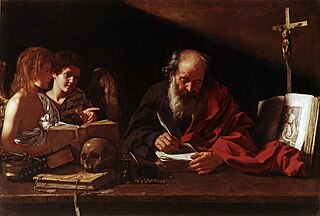
A hermit, or eremite, is a person who lives in seclusion from society, usually for religious reasons. Hermits are a part of several sections of Christianity, and the concept is found in other religions as well.


